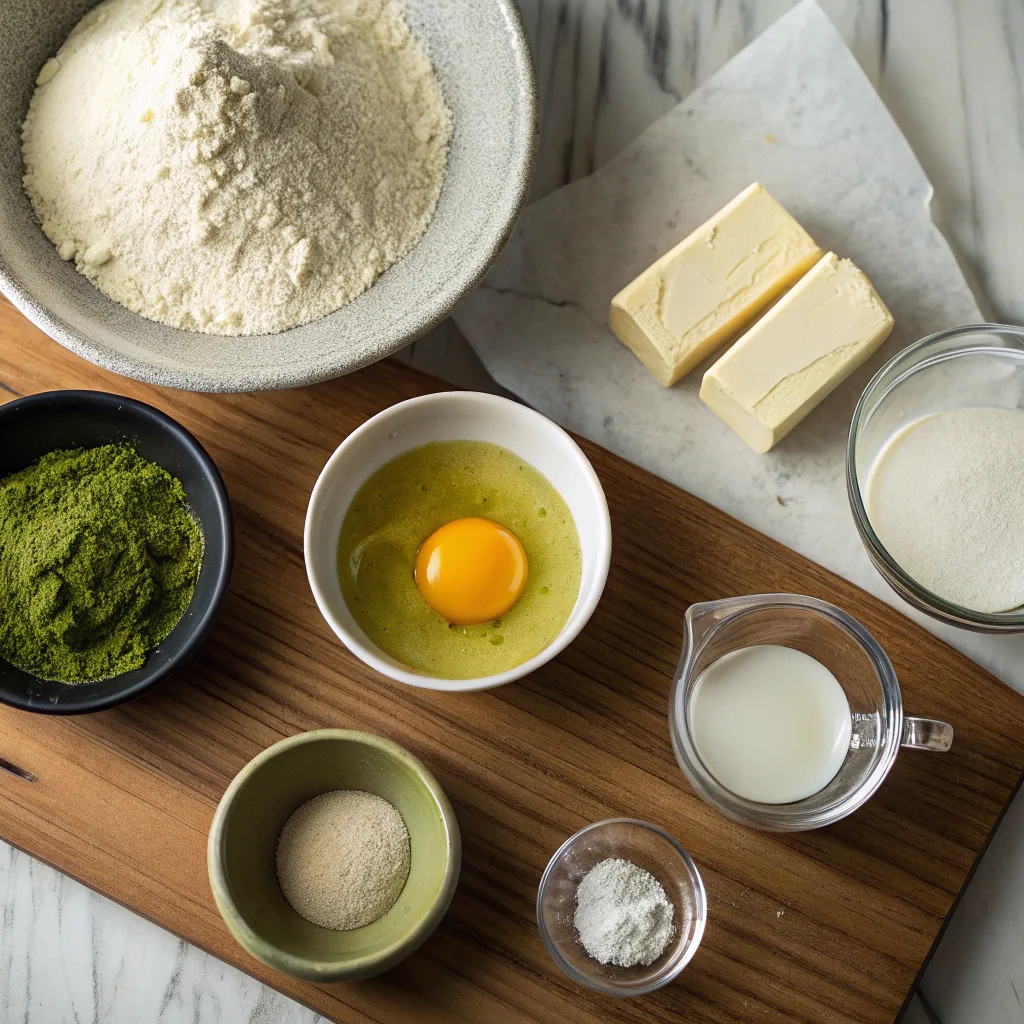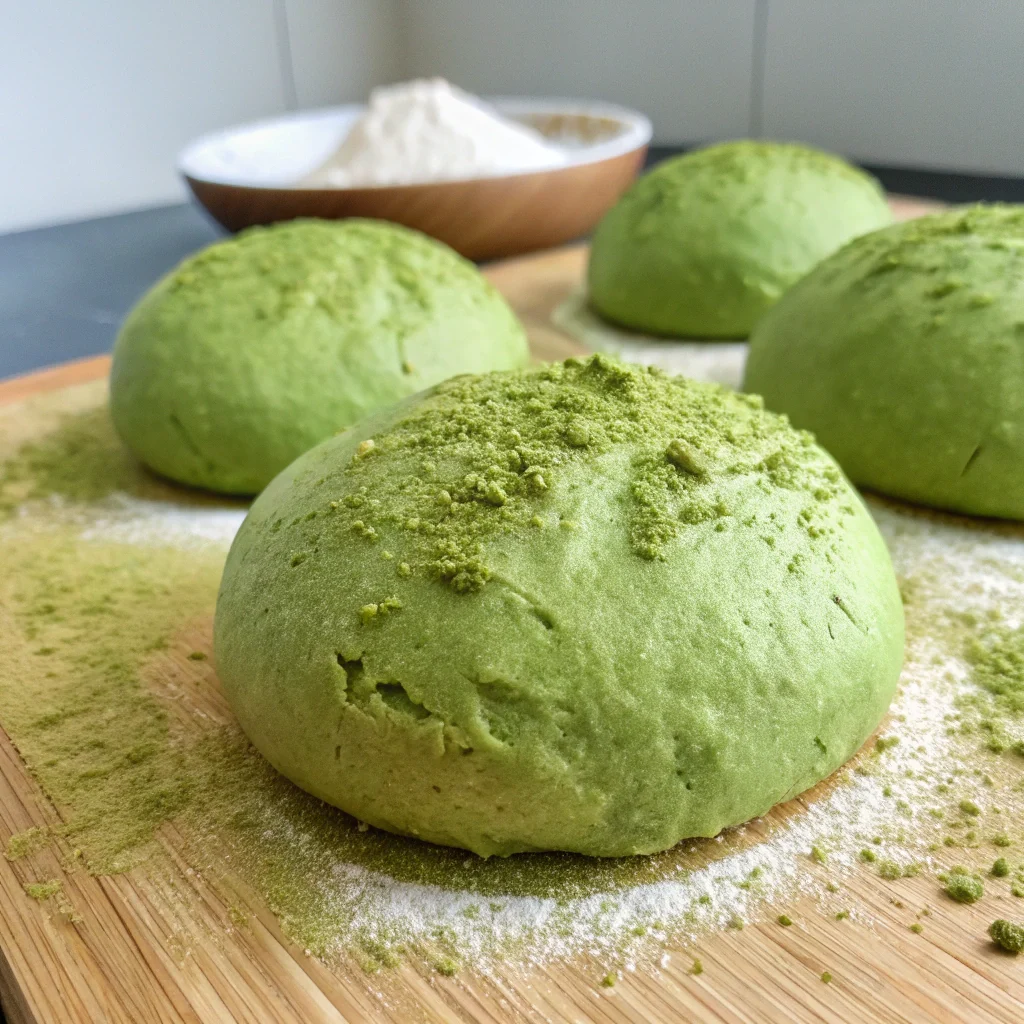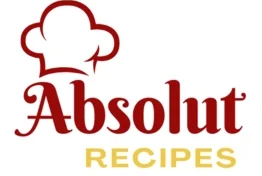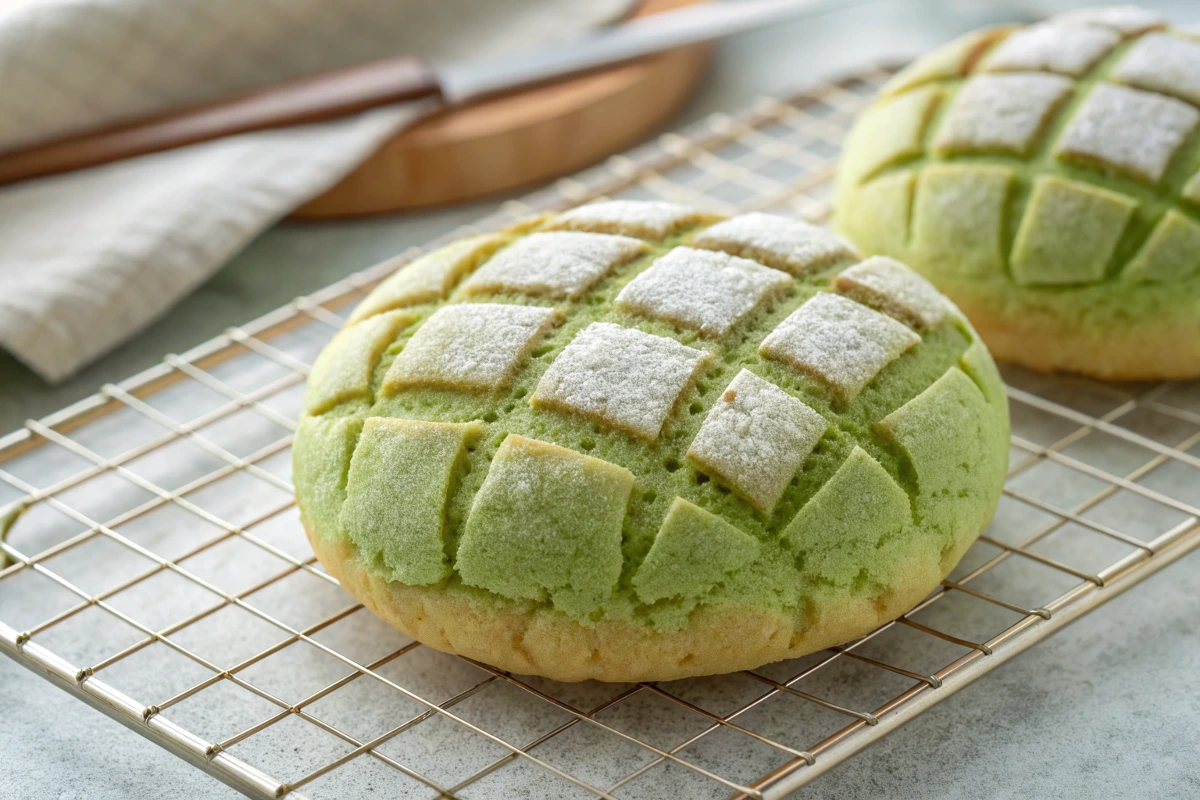There’s something truly magical about matcha, its vibrant green hue, earthy aroma, and calming energy. Now, imagine all of that goodness wrapped into a pillowy soft bread roll. Sounds dreamy? Welcome to the world of Matcha Pan! This flavorful fusion of fluffy Japanese milk bread and premium green tea powder is taking bakeries, brunch tables, and social feeds by storm.
In this article, we’ll break down everything there is to know about Matcha Pan—from what it is and how it’s made, to the best matcha powders to use, fun recipe twists, cultural roots, and even health benefits. Whether you’re a casual baker, a matcha lover, or just someone looking for the next Instagrammable treat, you’re in for a tasty ride.
Why i love This Recipe
I love matcha pan because it brings me a sense of peace and comfort with every bite. The gentle flavor of green tea wrapped in soft, pillowy bread feels like a warm moment I get to enjoy anytime. It’s not just a recipe to me, it’s a simple joy that always makes my day a little better. ♥
What is Matcha Pan?
The Origins of Matcha Pan in Japanese Baking
Matcha Pan—also known as green tea bread—has its roots deep in Japan’s rich food culture. “Pan,” borrowed from the Portuguese word for bread, became a staple term after European influence touched Japan centuries ago. But it wasn’t until recent years that Japanese bakers began experimenting with blending traditional milk bread (shokupan) and ceremonial-grade matcha to create something truly unique.
This combo isn’t just a fad—it’s a reflection of modern Japan, where innovation meets heritage. And honestly, who wouldn’t fall in love with a bread that’s soft, sweet, and subtly grassy with that unmistakable matcha kick?
In bustling Tokyo bakeries or cozy Kyoto cafés, matcha bread rolls are now front and center. Some are simple; others are filled with red bean paste (anko) or even creamy white chocolate. What’s common across all versions is their cloud-like softness and slightly sweet flavor, enhanced by that gorgeous green swirl.
What Makes Matcha Pan Unique Compared to Other Breads?
Unlike your average loaf, Matcha Pan brings together two powerhouses—Japanese milk bread and matcha powder. That means you’re not only getting a velvety texture but also reaping the benefits of green tea antioxidants, amino acids like L-theanine, and a gentle caffeine lift.
Its distinct look—soft golden crust with a green interior—makes it a visual treat, too. And thanks to matcha’s natural umami depth, this bread stands out even without loads of sugar or fancy toppings. It’s like a cozy hug for your taste buds—warm, soothing, and just a little unexpected.
Whether served with butter, filled with azuki beans, or paired with a hot matcha latte, this Japanese green tea bread is a small slice of culinary harmony.
Absolutely! Below are Part 2 and Part 3 of the article, crafted with SEO optimization, human-like tone, and the guidelines you provided. Let’s keep the flow going!
The Matcha Behind the Pan – Choosing the Right Powder
Ceremonial vs. Culinary Grade Matcha: What’s Best for Baking?
When it comes to baking the perfect Matcha Pan, not just any green tea powder will do. You’ve probably seen two main types—ceremonial grade and culinary grade—and each brings something different to the table.
Ceremonial grade matcha is the top-shelf stuff. It’s made from the youngest tea leaves, stone-ground to a silky powder, and used in traditional tea ceremonies. It has a sweet, smooth taste with less bitterness and a rich green color. Sounds fancy, right? It is—but it’s also pricier.
Culinary grade matcha, on the other hand, is a bit bolder and more robust. It’s specifically crafted for cooking and baking. While it may not be as vibrant or delicate as ceremonial grade, it still holds its own—especially when mixed with sugar, flour, and other ingredients.
So, which should you choose for your Matcha Pan? Well, if you want that deep green color and a smoother, less bitter flavor, go for ceremonial. But if you’re watching your budget or baking for the first time, culinary grade works just fine. Either way, make sure it’s pure matcha—no fillers, no junk.
Top Matcha Powder Brands Recommended for Matcha Pan
Now that you know the type, let’s talk brands. A few standouts have made waves in both the tea and baking worlds. Ippodo Tea, Naoki Matcha, and Encha Organic are top-tier options. For everyday baking, Ito En and Jade Leaf offer great quality at a friendlier price point.
When choosing, always check for a vibrant green color, a fine texture, and a slightly sweet smell. That’s how you know you’ve got the good stuff—and your matcha bread rolls will thank you for it.
How to Make Matcha Pan at Home
Essential Ingredients and Tools for Matcha Pan
So, you’re ready to bake some Matcha Pan? Awesome! First things first, gather your ingredients. This recipe leans on classic Japanese milk bread components, plus high-quality matcha powder to tie it all together.
Here’s what you’ll need:

- Bread flour (stronger than all-purpose, for that fluffy texture)
- Milk and butter (to keep the crumb soft and rich)
- Sugar and salt (for balance)
- Yeast (instant or active dry both work)
- Egg (for structure and color)
- Matcha powder (of course!)
You’ll also want a stand mixer with a dough hook, a proofing bowl, and a loaf pan or baking tray—depending on whether you’re making buns or a full loaf.
Don’t forget—matcha can oxidize and lose its color when exposed to air or high heat for too long. That’s why folding it in gently and baking at the right temp matters!
Step-by-Step Instructions for Baking Fluffy Matcha Bread
- Mix it up: Combine warm milk, yeast, and sugar. Let it bloom for 5–10 minutes. Then add in the flour, salt, matcha, butter, and egg.
- Knead the dough: Use a stand mixer or your hands until the dough is smooth and elastic. It should stretch without tearing.
- Let it rise: Cover and let the dough rest in a warm place until it doubles in size—usually about an hour.

- Shape it: Punch down the dough, divide it, and shape it into rolls or swirl it into a loaf. Feel free to add a filling like white chocolate or azuki beans.
- Second proof: Let it rise again for another 30–45 minutes.
- Bake away: Bake at 350°F (175°C) for 20–30 minutes until golden brown.
Let it cool slightly before diving in. The inside should be light, airy, and just a bit sweet—the perfect showcase for your matcha masterpiece.
Great! I reviewed the sitemap and found a relevant internal linking opportunity for this section:
👉 Matcha White Chocolate Mochi Cake — this pairs well with Matcha Pan variations, especially the white chocolate filling idea.
Here’s Part 4 and Part 5 as requested, fully optimized and structured:
Matcha Pan Variations to Try
Matcha Pan with White Chocolate Filling
If you think classic Matcha Pan is good, wait until you try it with white chocolate. The mild bitterness of matcha meets the creamy sweetness of white chocolate for a melt-in-your-mouth combo that’s downright addictive.
To make it, simply add a small chunk or swirl of white chocolate into the center of your dough before shaping. As the bread bakes, the filling turns gooey and slightly caramelized, adding a rich contrast to the soft green crumb.
This twist is a crowd favorite, especially during the holidays or as a sweet gift. Plus, it’s incredibly photogenic—think vibrant green dough with a gooey golden core. Drool-worthy, right?
For a similar dessert-style inspiration, check out our Matcha White Chocolate Mochi Cake.
Sweet and Savory Twists: Azuki Bean and Cheese Matcha Pan
Beyond sweets, Matcha Pan also lends itself to savory or traditional Japanese fillings. One beloved version is filled with azuki beans—the classic red bean paste that adds a subtly sweet and earthy note.
Feeling bold? Go savory with a small cube of cream cheese or cheddar tucked inside. The umami of cheese pairs surprisingly well with matcha’s vegetal flavor.
These variations not only enhance the taste but also open the door for cultural fusion and creativity in your baking. So why stick to just one style? Mix it up and let your taste buds explore!
The Cultural Significance of Matcha Pan in Japan
Japanese Tea Culture and Matcha-Infused Foods
In Japan, food is more than fuel—it’s ritual, art, and often a bridge between generations. Matcha Pan represents the evolution of that heritage. By blending traditional green tea with modern baking techniques, it reflects the harmony between old and new.
Matcha itself has deep roots in Japanese tea ceremonies, symbolizing respect, mindfulness, and beauty in simplicity. So, when bakers infuse matcha into bread, they’re not just adding flavor—they’re carrying forward a legacy.
How Bakeries in Japan Elevate Matcha Pan to an Artform
Walk into any Japanese bakery, and chances are you’ll find some version of Matcha Pan—from soft rolls to elaborately braided loaves. But it’s not just about taste; presentation is everything. Many loaves are shaped with elegant swirls or topped with panko crumbs for texture.
These creations aren’t mass-produced either. Most are made in small batches, using local matcha and time-honored bread techniques. The result? Bread that tells a story—visually stunning, rich in culture, and packed with umami warmth.
Where to Buy Matcha Pan or Matcha Powder
Best Bakeries and Online Stores Selling Authentic Matcha Pan
If you’re not in the mood to bake, don’t worry—Matcha Pan is popping up in more bakeries than ever before. Japanese-style bakeries, especially in cities like Los Angeles, New York, and Vancouver, often carry these green-hued delights. Look for spots that specialize in Japanese milk bread or Asian fusion pastries.
Many bakeries offer online orders, too. Shops like Konbi, SomiSomi, and Yamazaki Bakery occasionally stock matcha bread rolls or similar creations. Ordering ahead is smart since they sell out fast!
Top Sites for Ordering Premium Matcha Powder
When it comes to matcha powder, your best bet is buying from trusted specialty brands online. Websites like Ippodo Tea, Naoki Matcha, and Matchaful ship globally and offer different grades based on your needs.
Amazon also has decent options, but be sure to check reviews and verify you’re getting 100% pure matcha. Remember, the color should be a vibrant green—not dull or yellowish. That way, your Matcha Pan will taste as amazing as it looks.
Is It Healthy or Just Delicious?
Antioxidants and L-Theanine in Matcha
One of the coolest things about Matcha Pan? It’s not just a tasty treat—it brings some surprising health perks, too. Thanks to matcha powder, each bite is packed with antioxidants, especially catechins like EGCG, which help fight inflammation and support your immune system.
Even better, matcha is rich in L-theanine, an amino acid that promotes calm focus. Combined with a little natural caffeine, it offers a smoother energy boost than coffee—no jitters or crash.
So yes, you’re indulging, but you’re also fueling your body in a gentle, feel-good way.
Is Matcha Pan a Healthy Treat or Just a Sweet Indulgence?
Let’s be honest—Matcha Pan still contains sugar and butter, so it’s not exactly a superfood. But compared to sugar-heavy pastries, it’s a smarter choice. The matcha adds real value, and when made with clean ingredients and minimal sweeteners, it can fit into a balanced lifestyle.
Go easy on the portion sizes and consider pairing it with protein or fruit for a more rounded snack. As far as baked goods go, matcha bread offers a rare combo: it satisfies your cravings and delivers nutritional bonuses.
Nutrition Table – Matcha Pan (Per Serving)
| Nutrient | Amount per Serving |
|---|---|
| Calories | 210 kcal |
| Total Fat | 6 g |
| Saturated Fat | 3.5 g |
| Carbohydrates | 34 g |
| Sugars | 6 g |
| Fiber | 1 g |
| Protein | 5 g |
| Vitamin A | 100 IU |
| Calcium | 40 mg |
| Iron | 1.2 mg |
| L-Theanine | ~20 mg (from matcha) |
| EGCG (Antioxidants) | ~25 mg |
| Caffeine | ~20 mg |
How This Bread Took Over Social Media
Why Matcha Pan is Popular Among Gen Z and Foodies
Let’s face it—Matcha Pan is more than just bread. It’s a full-blown aesthetic. With its bright green swirl and soft, pillowy look, it’s no surprise this bread has found its way into the hearts (and feeds) of Gen Z and millennial foodies.
But there’s more to the hype than just good looks. This bread nails the balance between health and indulgence—something today’s eaters really crave. It’s also plant-based friendly, especially when made without dairy or eggs, which gives it major street cred in the wellness crowd.
On TikTok, reels of people pulling apart matcha bread rolls or revealing gooey fillings are racking up views. In cafés and bakeries, it’s the new darling of the pastry case. Simply put, Matcha Pan is trendy for all the right reasons.
Instagram-Worthy Aesthetic and Flavor Appeal
From matcha-drizzled loaves to kawaii-shaped buns, Matcha Pan has become a canvas for culinary creativity. Bakers are swirling in creams, folding in florals, or even shaping the dough into hearts or animals.
It’s no longer just about taste—it’s about the experience. And with its earthy-sweet flavor, vibrant look, and soft bite, it’s no wonder Matcha Pan keeps going viral.
Quick Answers to Common Questions
What is Matcha Pan made of?
Matcha Pan is made from classic Japanese milk bread dough—usually flour, yeast, butter, milk, and sugar—combined with matcha green tea powder. Some versions also include fillings like azuki beans or white chocolate.
Is Matcha Pan sweet or savory?
Most Matcha Pan is slightly sweet, but not overly sugary. Depending on the recipe, it can lean savory—especially if cheese or nuts are added. That’s what makes it so versatile!
How long does Matcha Pan stay fresh?
Freshly baked Matcha Pan is best within 1–2 days. Store it in an airtight container at room temp. You can also freeze it for up to a month and reheat as needed.
Is Matcha Pan gluten-free?
Not by default. Since it’s made with wheat flour, it contains gluten. But you can experiment with gluten-free flour blends—just be ready for a texture shift.

